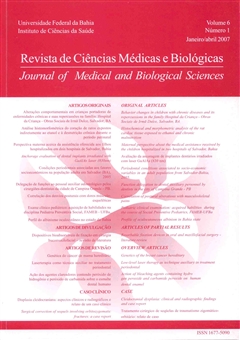Profile of oculocutaneous albinism in Bahia state
DOI:
https://doi.org/10.9771/cmbio.v6i1.4152Keywords:
Albinism- Low vision- Genetic counseling, OCA1, OCA2.Abstract
The albinism is a heterogeneous group of genetic disturbances that affects melanina production, able to lead to hypopigmentation of the skin, fur, hair and eyes. The objective of this work was to analyze genetic aspects and health problems in consequence of oculocutaneous albinism. It was used a sampling of convenience, using as instrument for data collection, semi-structured questionnaires applied to 40 subjects (23 females and 17 males) from families associated to APALBA (Association of the Carriers of Albinism of Bahia). The albinos were offspring of normal pigmented parents, carriers of the recessive mutant allele. The majority, (65%), refers heredity, with more than one case in the family, and ethnic origin predominantly black. The usual diagnostic of albinism follows clinic criteria, although laboratory methods, able to identify some mutations, are already available. The absence of assistance to the affected people contributes for the low vision and risks of skin cancer. The study indicates the necessity of a new model of assistance to albinos, with preventive measures to the health damages, and that also includes, in the indicated cases, laboratorial tests with techniques from molecular biology that can contribute for the genetic counseling of the condition.Downloads
Download data is not yet available.
Downloads
Published
2007-01-01
How to Cite
Moreira, L. M. de A., Moreira, S. C., Cabanelas, I. T. D., & Rocha, L. de M. (2007). Profile of oculocutaneous albinism in Bahia state. Journal of Medical and Biological Sciences, 6(1), 69–75. https://doi.org/10.9771/cmbio.v6i1.4152
Issue
Section
ORIGINAL ARTICLES
License
The Journal of Medical and Biological Sciences reserves all copyrights of published works, including translations, allowing, however, their subsequent reproduction as transcription, with proper citation of source, through the Creative Commons license. The periodical has free and free access.


